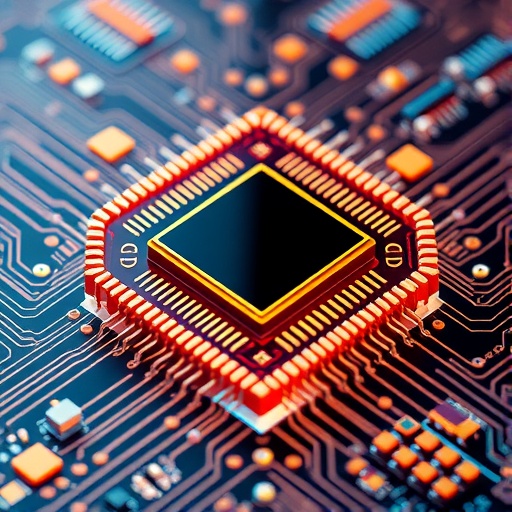
In an era where the demand for efficient and high-performance electronic devices is at an all-time high, the discovery and integration of advanced semiconductor materials have become paramount. Among these materials, gallium nitride (GaN) stands out due to its ability to outperform traditional silicon in several applications, particularly in high-speed communication systems and power electronics. However, despite its potential, the commercial viability of GaN has been hampered by its cost and the complexity involved in integrating it with standard silicon-based technologies. However, recent research from the Massachusetts Institute of Technology (MIT) and collaborators has heralded a breakthrough that could pave the way for a new era of hybrid electronic devices, utilizing the unique properties of GaN while sidestepping many of the barriers that previously limited its adoption.
The research team has developed a novel fabrication process designed to efficiently integrate high-performance GaN transistors onto traditional silicon complementary metal-oxide-semiconductor (CMOS) chips. This approach promises to make GaN technology more accessible and economically sustainable, all while maintaining compatibility with existing semiconductor manufacturing processes. The innovative method hinges on utilizing miniature GaN transistors, which are fabricated on a GaN wafer, and subsequently transferred onto a silicon chip with remarkable precision.
Central to this process is the team’s ability to cut out individual transistors from a densely packed GaN wafer, allowing them to bond only the necessary components onto the silicon substrate. By employing a low-temperature bonding technique with copper pillars, the researchers successfully preserve the integrity of both the GaN and silicon materials, effectively sidestepping limitations posed by traditional techniques which often rely on more heat-intensive and costly methods involving materials like gold.
.adsslot_z5vg2KyD1x{width:728px !important;height:90px !important;}
@media(max-width:1199px){ .adsslot_z5vg2KyD1x{width:468px !important;height:60px !important;}
}
@media(max-width:767px){ .adsslot_z5vg2KyD1x{width:320px !important;height:50px !important;}
}
ADVERTISEMENT
The advantage of the proposed fabrication technique is multifaceted; it significantly reduces the cost associated with GaN, as only minimal amounts of the material are required. This shift towards a more economical use of GaN not only enhances the performance of the resulting devices—thus improving metrics such as signal strength and energy efficiency—but also contributes to a more sustainable approach to electronics design. The spartan approach to GaN utilization ensures that excess material is minimized, while also facilitating thermal management, an essential factor in maintaining optimal operational conditions for electronic systems.
As the research team delved further into demonstrating the effectiveness of their fabrication process, they fabricated a power amplifier that significantly outperformed its silicon-only counterparts. This power amplifier, a crucial element in mobile phones and wireless communication systems, boasts enhanced signal strength, greater bandwidth, and improved energy efficiency. The takeaways from this development point to a future where smartphones equipped with such amplifiers can provide better call quality, accommodate higher data transfer rates, extend battery life, and offer seamless connectivity—capabilities that are increasingly demanded by users in our interconnected world.
Beyond immediate commercial applications, the researchers suggest that their innovative fabrication technique holds promise for future technologies, potentially unlocking advancements in quantum computing. Gallium nitride’s performance at cryogenic temperatures, often required in quantum applications, positions it as a material of choice for next-generation computing paradigms. This blending of the best attributes of both gallium nitride and silicon electronics could spearhead a wave of advancements that would transform several electronic markets, leading to devices that are not only more powerful but also more versatile.
To achieve this level of precision and integration, the research team developed specialized new tools that facilitate the bonding of the extremely small GaN transistors to the silicon chips. This meticulous process involves sophisticated techniques such as advanced microscopy to ensure that the dielet—a minuscule chip measuring just 240 by 410 microns—is accurately and securely positioned for integration. Subsequently, controlled heat and pressure are applied to create a robust bond, marking a significant leap in the scalability of GaN technology.
Executing such a complex fabrication process required extensive collaboration and innovation, with the lead author noting that each step necessitated learning new techniques from collaborators and integrating them into their platform. This interdisciplinary approach highlights the intricacies of modern semiconductor research, where continuous learning and adaptation are essential for success. Together, the researchers have mapped out a pathway to enhance electronic devices, reinforcing the notion that hybrid systems utilizing both GaN and silicon can bridge the performance gap that has long existed within the electronics industry.
Given that gallium nitride is the second most common semiconductor material utilized globally, it is crucial for research focusing on its integration with silicon technologies to continue evolving. This latest breakthrough not only embodies a significant advance in semiconductor technology but also provides a glimpse into the future where high-performance, sustainable electronics are accessible to a broader market. The implications of successfully merging GaN and silicon semiconductors are profound, with potential applications spanning from consumer electronics to advanced computing systems.
Lastly, this research is supported in part by the U.S. Department of Defense and various esteemed institutions, further emphasizing the collaborative nature of scientific discovery. As the world continues to lean towards more efficient and sustainable technology, the implications of the integration of GaN into mainstream electronics have the potential to greatly influence the landscape of future electronic innovations. The journey from theoretical research to practical application is now well on its way, thanks to the relentless efforts of researchers dedicated to advancing semiconductor technology.
The ground-breaking work being done at MIT and its collaborative partners serves not only as a focal point for the future of semiconductor materials but also exemplifies the spirit of innovation and teamwork that drives scientific progress. As researchers continue to devise solutions that lower costs while enhancing performance, the landscape of electronics will undoubtedly be transformed, making way for an era of smarter, faster, and more efficient technology.
In conclusion, the merging of gallium nitride with traditional silicon technologies not only signifies a leap in capabilities but also represents a thoughtful approach towards sustainable semiconductor usage. This revolution in electronic fabrication is poised to have lasting impacts across various sectors, heralding a new age of high-performance electronic devices that are more affordable and accessible than ever before.
Subject of Research: Integration of Gallium Nitride Transistors on Silicon Chips
Article Title: Revolutionary Integration of GaN Transistors on Silicon Chips Paves the Way for High-Speed Electronics
News Publication Date: October 2023
Web References:
References:
Image Credits:
Keywords
Tags: 3D chip technologyadvanced fabrication processesCMOS chip innovationcost-effective semiconductor solutionsenergy efficient electronicsfuture of electronics manufacturinggallium nitride advantagesGaN integration with siliconhigh-speed communication systemshybrid electronic devicesMIT research on GaNsemiconductor material breakthroughs



